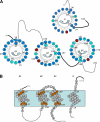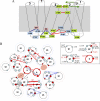Mapping the interactions between Escherichia coli TolQ transmembrane segments
- PMID: 21285349
- PMCID: PMC3064227
- DOI: 10.1074/jbc.M110.192773
Mapping the interactions between Escherichia coli TolQ transmembrane segments
Abstract
The tolQRAB-pal operon is conserved in Gram-negative genomes. The TolQRA proteins of Escherichia coli form an inner membrane complex in which TolQR uses the proton-motive force to regulate TolA conformation and the in vivo interaction of TolA C-terminal region with the outer membrane Pal lipoprotein. The stoichiometry of the TolQ, TolR, and TolA has been estimated and suggests that 4-6 TolQ molecules are associated in the complex, thus involving interactions between the transmembrane helices (TMHs) of TolQ, TolR, and TolA. It has been proposed that an ion channel forms at the interface between two TolQ and one TolR TMHs involving the TolR-Asp(23), TolQ-Thr(145), and TolQ-Thr(178) residues. To define the organization of the three TMHs of TolQ, we constructed epitope-tagged versions of TolQ. Immunodetection of in vivo and in vitro chemically cross-linked TolQ proteins showed that TolQ exists as multimers in the complex. To understand how TolQ multimerizes, we initiated a cysteine-scanning study. Results of single and tandem cysteine substitution suggest a dynamic model of helix interactions in which the hairpin formed by the two last TMHs of TolQ change conformation, whereas the first TMH of TolQ forms intramolecular interactions.
Figures





Similar articles
-
Mapping the interactions between escherichia coli tol subunits: rotation of the TolR transmembrane helix.J Biol Chem. 2009 Feb 13;284(7):4275-82. doi: 10.1074/jbc.M805257200. Epub 2008 Dec 15. J Biol Chem. 2009. PMID: 19075020
-
Movements of the TolR C-terminal domain depend on TolQR ionizable key residues and regulate activity of the Tol complex.J Biol Chem. 2007 Jun 15;282(24):17749-57. doi: 10.1074/jbc.M701002200. Epub 2007 Apr 18. J Biol Chem. 2007. PMID: 17442676
-
The TolQ-TolR proteins energize TolA and share homologies with the flagellar motor proteins MotA-MotB.Mol Microbiol. 2001 Nov;42(3):795-807. doi: 10.1046/j.1365-2958.2001.02673.x. Mol Microbiol. 2001. PMID: 11722743
-
Energetics of colicin import revealed by genetic cross-complementation between the Tol and Ton systems.Biochem Soc Trans. 2012 Dec 1;40(6):1480-5. doi: 10.1042/BST20120181. Biochem Soc Trans. 2012. PMID: 23176502 Review.
-
The Tol proteins of Escherichia coli and their involvement in the uptake of biomolecules and outer membrane stability.FEMS Microbiol Lett. 1999 Aug 15;177(2):191-7. doi: 10.1111/j.1574-6968.1999.tb13731.x. FEMS Microbiol Lett. 1999. PMID: 10474183 Review.
Cited by
-
Evolution of the Stator Elements of Rotary Prokaryote Motors.J Bacteriol. 2020 Jan 15;202(3):e00557-19. doi: 10.1128/JB.00557-19. Print 2020 Jan 15. J Bacteriol. 2020. PMID: 31591272 Free PMC article. Review.
-
The multifarious roles of Tol-Pal in Gram-negative bacteria.FEMS Microbiol Rev. 2020 Jul 1;44(4):490-506. doi: 10.1093/femsre/fuaa018. FEMS Microbiol Rev. 2020. PMID: 32472934 Free PMC article. Review.
-
Recruitment of the TolA Protein to Cell Constriction Sites in Escherichia coli via Three Separate Mechanisms, and a Critical Role for FtsWI Activity in Recruitment of both TolA and TolQ.J Bacteriol. 2022 Jan 18;204(1):e0046421. doi: 10.1128/JB.00464-21. Epub 2021 Nov 8. J Bacteriol. 2022. PMID: 34748387 Free PMC article.
-
Hyperglycemia promotes myocardial dysfunction via the ERS-MAPK10 signaling pathway in db/db mice.Lab Invest. 2022 Nov;102(11):1192-1202. doi: 10.1038/s41374-022-00819-2. Epub 2022 Aug 8. Lab Invest. 2022. PMID: 35941186 Free PMC article.
-
The N-terminal membrane-spanning domain of the Escherichia coli DNA translocase FtsK hexamerizes at midcell.mBio. 2013 Dec 3;4(6):e00800-13. doi: 10.1128/mBio.00800-13. mBio. 2013. PMID: 24302254 Free PMC article.
References
Publication types
MeSH terms
Substances
LinkOut - more resources
Full Text Sources
Other Literature Sources
Molecular Biology Databases

